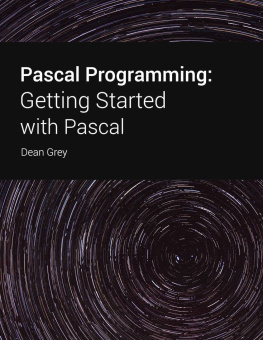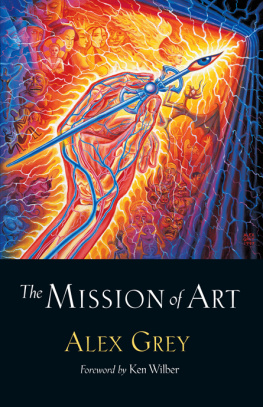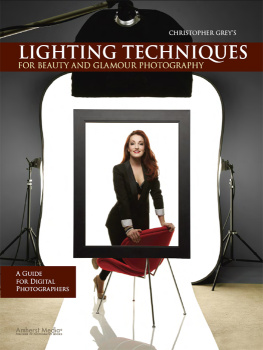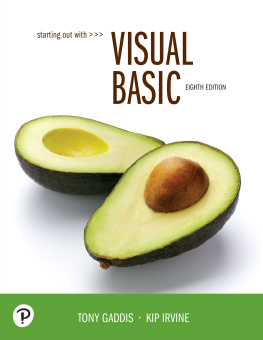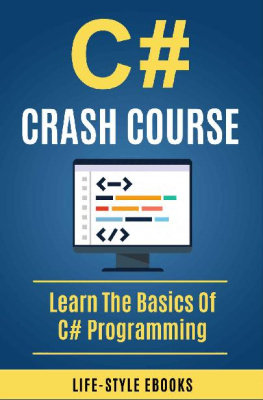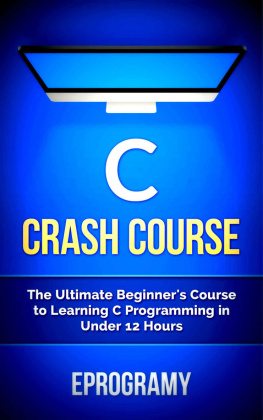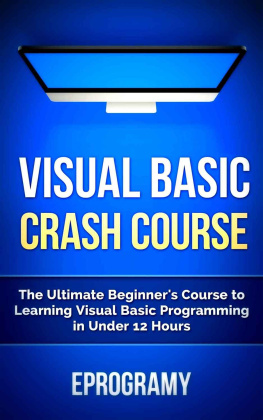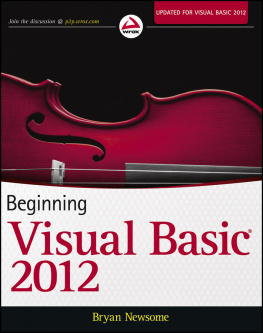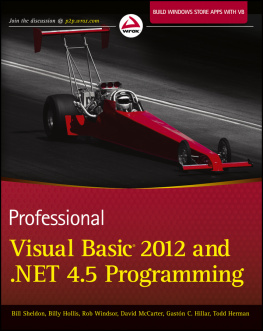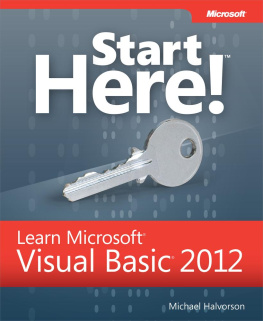Grey - Visual Basic Crash Course: The Ultimate Beginner’s Course to Learn Visual Programming in 12 Hours
Here you can read online Grey - Visual Basic Crash Course: The Ultimate Beginner’s Course to Learn Visual Programming in 12 Hours full text of the book (entire story) in english for free. Download pdf and epub, get meaning, cover and reviews about this ebook. year: 2021, genre: Computer. Description of the work, (preface) as well as reviews are available. Best literature library LitArk.com created for fans of good reading and offers a wide selection of genres:
Romance novel
Science fiction
Adventure
Detective
Science
History
Home and family
Prose
Art
Politics
Computer
Non-fiction
Religion
Business
Children
Humor
Choose a favorite category and find really read worthwhile books. Enjoy immersion in the world of imagination, feel the emotions of the characters or learn something new for yourself, make an fascinating discovery.

Visual Basic Crash Course: The Ultimate Beginner’s Course to Learn Visual Programming in 12 Hours: summary, description and annotation
We offer to read an annotation, description, summary or preface (depends on what the author of the book "Visual Basic Crash Course: The Ultimate Beginner’s Course to Learn Visual Programming in 12 Hours" wrote himself). If you haven't found the necessary information about the book — write in the comments, we will try to find it.
Visual Basic Crash Course: The Ultimate Beginner’s Course to Learn Visual Programming in 12 Hours — read online for free the complete book (whole text) full work
Below is the text of the book, divided by pages. System saving the place of the last page read, allows you to conveniently read the book "Visual Basic Crash Course: The Ultimate Beginner’s Course to Learn Visual Programming in 12 Hours" online for free, without having to search again every time where you left off. Put a bookmark, and you can go to the page where you finished reading at any time.
Font size:
Interval:
Bookmark:
VISUAL BASI C CRASH COURS E
The Ultimate Beginners Course t o
Learn Visual Programming in Unde r
Hour s
By Dean Grey
Chapter
Visual Basic Programming Language
History of Visual Basic
In History of Programming there are tons of programming languages were introduced and used by worldwide. But one particular programming language change everything in computer programming which is Visual Basic because It is totally stand alone when you compare with normal programming languages. Once upon a time GUI Applications are the most critical one in computing. It also tough one to develop. Because everything done through codes.
Before Visual Basic, Windows components are developed by C++. It contains many bugs so it reduce the performance of windows. So Microsoft decided to develop a new programming languages which makes everything simple and efficient one. Finally Visual Basic was born and it make many revolutionary changes in windows.
In 1991 History was re-written GUI Application development becomes easy. Yes! Microsoft introduced Visual Basic so the most powerful programming language was born. Visual Basic helps everyone to develop GUI applications by just drag-drop so you dont need to write hard code to create the user interface you can create everything by drag and drop properties.
Visual Basic is a programming which allows developer to develop Graphical User Interface by using Drag and Drop properties. It is developed by Alan Cooper. He use traditional BASIC Programming language concepts to develop Visual Basic. With help of Visual Basic IDE a Programmer can develop a simple to Complex GUI Programs.
Till now there are many Versions of Visual Basic are introduced. First version Visual Basic 1.0 was introduced in May 1991.Most Successful version of Visual Basic 6.0 were introduced in mid of 1998. It supports web and desktop application development. Later it entered Microsofts Non Supported phase because they introduced Visual Basic .net. It is nothing but a successor of Visual Basic 6.0. Some call it as Visual Basic 7.0. But Runtime of Visual Basic supported in Windows XP, Vista, Windows Server 2008 and Windows
What is Visual Basic?
Visual Basic is a Programming Language which is used to develop Simple to Complex GUI Applications using drag and drop components of Visual Basic IDE. We can call it as Development Environment too Because It has Program development as well as executing capability. Visual Basic was developed Alan Cooper using BASIC Programming Language. Syntax of Visual Basic is completely different when you compare with other famous programming languages such as C, C++, Java and C #.
Visual Basic is different from other programming languages because of its simplicity and powerful nature. That combination makes the Visual Basic programming language great to use. Visual Basic is not a true Object Oriented Programming Language. It may called as event-driven language because each object can react to different events such as mouse click, text change , mouse over, got focus.
In Visual Basic we dont need to worry about the syntax because Programmer can easily drag and drop the components (Buttons, Check box, Text box etc.) over the form (Form is nothing but a Container which is used to place different set of controls).
The programmer can create executable files using Visual Basic IDE and He can develop his own customized component by ActiveX Controls (ActiveX controls help developer to create their own components in VB and it can be used in their application just like other components).
The success of Visual Basic Programming is simple and powerful features to develop efficient applications. We can use Visual basic programming concepts in many areas of Microsoft such as Macro Programming and VBA (Visual Basic Applications). We can create Macros using Visual Basic Programming it help us to reduce the complexity of MS Office.
VB Programming concepts used in Web and Desktop application development too. In VB-Script most of the concepts derived from VB. It is used to handle the users data in Websites or Web Application. If you know VB then you can easily understand the other concepts of Microsoft tools.
Chapter
Installation of Visual Basic
If you are interested in developing applications using Visual Basic mean you need to have these tools in your system.
Visual Studio IDE
Any Database Application (For developing Data Storage applications)
The download of these two tools will put you on your way to becoming a VB programmer. An IDE (integrated development environment) is a packaged application program used by programmers because it contains necessary tools in order to process and execute code. An IDE contains a code editor, a compiler, a debugger, and a graphical user interface (GUI). You can download Visual Basic
6.0 enterprise from this official site of Microsoft but you need MSDN Subscription to download the setup.
https://msdn.microsoft.com/en-us/default.aspx
After downloading the setup you have can install it.

After downloading the setup file you can install. Click the setup file then automatically installation process will be started. First Visual Studio Enterprise edition welcomes just click next button complete all installation process. If you successfully install it your IDE look like this.

Select Standard EXE then click Open button now new project will be opened. There you can develop the application. New project contains one form.

Important Parts in IDE
Form Window
Code Window
Property Window
Project Explorer
Tool box
Form Window
Form window help us to design the User Interface. Form window contains a Form which is nothing but a container there we can place our components such as Buttons, Text box, Checkbox and Radio button etc. Here I attached the example of Form window.

Code Window
Code window is used to add the program code to the application. There we can create our own methods, procedure and functions. Code window look like this.

Property Window
Property window contains information about the components which is placed on the form. We can change the behaviour as well as appearance of the component such as background colour of the button, font colour etc.

Project Explorer
Project shows the information such as how many forms available in the project. In Project explorer you can see three icons which is used to open Code window, Object window and Toggle folder.

Tool box
Tool box contains the set of controls with help of this Tool box you can easily place the control on the form. Just click the tool then place into form.
Next pageFont size:
Interval:
Bookmark:
Similar books «Visual Basic Crash Course: The Ultimate Beginner’s Course to Learn Visual Programming in 12 Hours»
Look at similar books to Visual Basic Crash Course: The Ultimate Beginner’s Course to Learn Visual Programming in 12 Hours. We have selected literature similar in name and meaning in the hope of providing readers with more options to find new, interesting, not yet read works.
Discussion, reviews of the book Visual Basic Crash Course: The Ultimate Beginner’s Course to Learn Visual Programming in 12 Hours and just readers' own opinions. Leave your comments, write what you think about the work, its meaning or the main characters. Specify what exactly you liked and what you didn't like, and why you think so.

